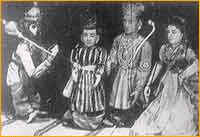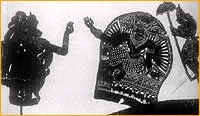Fusion
WORLD MUSIC
RAMAYANA THEATRE IN INDIA AND SOUTH-EAST ASIA - PART 2



To be concluded
Posted on 13th June 2001
Fusion |
|
WORLD MUSIC |
|
RAMAYANA THEATRE IN INDIA AND SOUTH-EAST ASIA - PART 2 |
|
| The most ancient form of theatre employing the Rama theme in many countries is the shadow theatre. It is the shadow theatre that has given rise to several forms of human theatre. The puppet theatre is also the oldest form using the Ramayana theme. Much of the Ramayana theatre including puppet theatre evolved out of recitation which acts as a baseline upon which the superstructure of the form is raised. In India, the strongest tradition of the shadow theatre is that of Andhra Pradesh, other regional traditions being those of Orissa, Karnataka and Kerala. Notwithstanding many common features and conventions, the four styles of shadow theatre differ in size and delineation of figures and in the spoken word, material and music content. Other forms of the puppet theatre presenting Rama stories, are the rod-puppets of West Bengal, the glove puppets of Kerala and the marionettes of Tamilnadu and Karnataka. These Indian theatrical forms are spread out in many of the South-East Asian theatres on Ramayana. | |
| The shadow theatre of Java and Bali is the most developed and highly cultivated. With its deep ritualistic background and symbolic character, it has a great socio-cultural significance and truly mirrors the beliefs, attitude and traditions of the Indonesian people. With the spoken word material of rich poetic content, elaborate and codified music, magnificent and highly stylised figures, and developed art of manipulation and vocalisation, Indonesian ‘Wayang Kulit’ provides a total theatrical experience. There is a very strong Indian influence in the Ramayana theatres of Indonesia. |
|
| The tradition of the shadow theatre existed in Thailand which is 'Nang Yai', a shadow play on the Ramayana theme. The leather puppets are cut, embossed and painted elaborately. The movements of the puppets vary according to the characters. In the Cambodian shadow theatre, figures are projected on a large screen employing a number of puppeteers in a performance especially during the royal processions and war scenes. | |
|
Apart from the shadow theatre, the Ramayana episodes are also presented in human theatre, wherein actors participate with masks or mask like make-up. The "khon" (means a mask) plays of Thailand have similar traits of the Kathakali dance of India. It is described as ‘masked play’ or masked pantomime. It is the oldest theatrical form still seen in Thailand. In Kathakali, though the masks are not used, mask-like make-up is done for the actors. |
| In Indonesia, Thailand and Cambodia, Rama is not protrayed merely as a God. Often he is portrayed as a romantic hero, specially in versions where he sends out Seeta in a fit of anger and envy after she has painted a portrait of Ravana on the fan. But in all versions, he is the embodiment of good. In all versions, Seeta is associated with the Earth who is believed to have come from the Earth and who goes back to the Earth. Hanuman epitomises calm, solid loyalty. In all versions, he is connected with ‘Vayu’ or wind and is the son of the wind God. In the Indian versions, he is a bachelor, but in Thai version, he is an amorous hero, father of the sons of the Apsaras. | |
| The Ramayana theatre is richest in episodes and spoken word material. There has always been a close link between the literary and the performing traditions of the Ramayana. Not only in human theatre, but also in the puppet theatre; the verses are taken from the Ramayana and other poetry on Rama. It is this richness of literary content that has been the main factor for the sustenance and survival of the puppet theatre in Asia for nearly 2,000 years. |
|
| During the medieval centuries, many poets wrote epic poems on the Rama saga keeping in view the performing tradition and its requirements. Some wrote the epic primarily to be performed. Thai Ramayana by King Rama IV and the Burmese Ramayana by Natak Kyaw Guang, are dramatic versions of the epic story composed for theatrical performance. They are similar to the Bengali Ramayana of Krittiwas and Vichitra Ramayana of Oriya which is used by the Ramayana theatres of these regions for textual material. The Ramacharitramanas of Tulsidas has a sound dramatic design and greatly enriched and sustained "Ramlila" (the traditional theatre of North India, which deals exclusively with the Rama theme). | |
To be concluded |
|
| Note: The author of this section on World music is none other than the expert Ethnomusicologist, Dr. S A K Durga. For any doubts and queries on this subject, please mail her. | |
|
Posted on 13th June 2001 |
|
| Fusion home | Hindustani music |
| The Javanese Gamelan | Western music |